The SUV market continues to grow, with consumers increasingly seeking vehicles that combine versatility, efficiency, and innovative features. Two notable contenders in this space are the Ford Kuga and Skoda Karoq. Both vehicles offer a range of powertrains and tech-savvy amenities to cater to diverse customer needs. In this comparison, we will delve into the technical aspects and innovations of these two SUVs.
Ford Kuga vs Skoda Karoq – Which car suits you better?
Both models have their strengths – but which one suits you more?
Compare performance, efficiency, price and space directly: Ford Kuga or Skoda Karoq?
Powertrain Options: Engine and Transmission
The Ford Kuga is available with a choice of petrol, full hybrid, and plug-in hybrid engines, offering flexibility depending on driver preferences. The petrol options provide outputs ranging from 150 to 243 horsepower, while hybrid options lean towards efficiency with emissions as low as 20 g/km. The Kuga also features a variety of transmissions, including a manual gearbox and a CVT automatic, alongside front-wheel and all-wheel drive configurations.
In contrast, the Skoda Karoq offers a lineup that includes both petrol and diesel engines. Power outputs range from 115 to 190 horsepower, with a focus on delivering a balance between performance and fuel efficiency. The Karoq features a manual and a dual-clutch automatic transmission, also available in both front and all-wheel drive setups. With a maximum speed capabilities reaching up to 221 km/h, the Karoq possesses a performance edge in certain variants.
Efficiency and Consumption
When it comes to fuel efficiency, the Ford Kuga boasts impressive consumption figures, especially in its hybrid variants that can achieve as low as 0.9 L/100 km. The petrol variants consume between 5.3 to 6.4 L/100 km. Its hybrid design also affords an electric range of up to 69 km, allowing for eco-friendly driving in urban environments.
The Skoda Karoq also holds its own in the efficiency department, with consumption figures ranging from 4.9 to 6.1 L/100 km across its various engine options. The diesel options can provide even better economy, appealing to long-distance travelers looking for a fuel-efficient vehicle. Both vehicles are equipped with fuel tank capacities that support longer trips, with the Kuga holding up to 54 L and the Karoq offering up to 55 L.
Dimensions and Interior Space
In terms of size, the Ford Kuga stretches out to lengths between 4604 mm and 4645 mm, while the Skoda Karoq is comparatively compact, measuring from 4384 mm to 4390 mm. The Kuga stands slightly taller than the Karoq, offering a commanding driving position at up to 1681 mm in height against the Karoq’s maximum height of 1624 mm. Both SUVs comfortably seat five passengers, and the Karoq edges ahead in trunk capacity, boasting a generous 521 L compared to the Kuga’s 412 L.
Innovations and Technology
Ford has packed the Kuga with innovative tech features, including Ford's latest SYNC infotainment system, which supports smartphone integration through Apple CarPlay and Android Auto, allowing for seamless connectivity on the go. Active safety features, such as adaptive cruise control and a blind-spot monitor, enhance the driving experience further.
The Skoda Karoq, on the other hand, offers a user-friendly infotainment system, complemented by a range of driver assistance technologies. Notable features include adaptive cruise control, lane assist, and parking sensors that make navigating tight urban areas a breeze. In addition, Skoda’s clever Simply Clever solutions provide practical touches like integrated umbrellas in the doors and a removable flashlight in the boot.
Conclusion: Which SUV Reigns Supreme?
Both the Ford Kuga and Skoda Karoq have their unique strengths, appealing to different segments of the automotive market. The Kuga excels with its hybrid options and advanced technology, making it ideal for environmentally conscious drivers. Conversely, the Karoq shines in spaciousness and practicality, offering a solid dual-fuel mechanical lineup along with innovative storage solutions.
Ultimately, potential buyers should consider their priorities—whether it's performance, technology, or space—when making their choice between these two capable SUVs. Regardless of the choice, both models signify the remarkable versatility and innovation present in today's automotive landscape.
Here’s where it gets real: The technical differences in detail
Costs and Efficiency:
Price and efficiency are often the first things buyers look at. Here it becomes clear which model has the long-term edge – whether at the pump, the plug, or in purchase price.
Skoda Karoq has a slightly advantage in terms of price – it starts at 29100 £, while the Ford Kuga costs 34200 £. That’s a price difference of around 5160 £.
Fuel consumption also shows a difference: Ford Kuga manages with 2.80 L and is therefore convincingly more efficient than the Skoda Karoq with 4.90 L. The difference is about 2.10 L per 100 km.
Engine and Performance:
Power, torque and acceleration say a lot about how a car feels on the road. This is where you see which model delivers more driving dynamics.
When it comes to engine power, the Ford Kuga has a clearly perceptible edge – offering 243 HP compared to 190 HP. That’s roughly 53 HP more horsepower.
In acceleration from 0 to 100 km/h, the Skoda Karoq is minimal quicker – completing the sprint in 7 s, while the Ford Kuga takes 7.30 s. That’s about 0.30 s faster.
In terms of top speed, the Skoda Karoq performs minimal better – reaching 221 km/h, while the Ford Kuga tops out at 200 km/h. The difference is around 21 km/h.
There’s also a difference in torque: Skoda Karoq pulls noticeable stronger with 360 Nm compared to 240 Nm. That’s about 120 Nm difference.
Space and Everyday Use:
Beyond pure performance, interior space and usability matter most in daily life. This is where you see which car is more practical and versatile.
Both vehicles offer seating for 5 people.
In curb weight, Skoda Karoq is somewhat lighter – 1380 kg compared to 1526 kg. The difference is around 146 kg.
In terms of boot space, the Skoda Karoq offers distinct more room – 521 L compared to 412 L. That’s a difference of about 109 L.
In maximum load capacity, the Skoda Karoq performs slight better – up to 1630 L, which is about 96 L more than the Ford Kuga.
When it comes to payload, Ford Kuga hardly perceptible takes the win – 550 kg compared to 549 kg. That’s a difference of about 1 kg.
Who comes out on top?
Overall, the Ford Kuga shows itself to be dominates this comparison and secures the title of DriveDuel Champion.
It convinces with the more balanced overall package and proves to be the more versatile choice for everyday use.
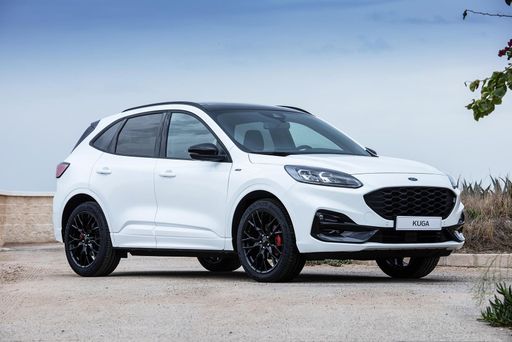 @ Ford Motor Company / Ford Media Center
@ Ford Motor Company / Ford Media Center
Ford Kuga
Ford Kuga
The Kuga is Ford’s adaptable family SUV that blends usable space with a surprisingly lively driving character, making daily commutes and weekend escapes equally enjoyable. With smart interior packaging, an easy-to-use infotainment setup and composed road manners, it’s a sensible choice for buyers who want a bit of fun without the fuss.
details @ Ford Motor Company / Ford Media Center
@ Ford Motor Company / Ford Media Center
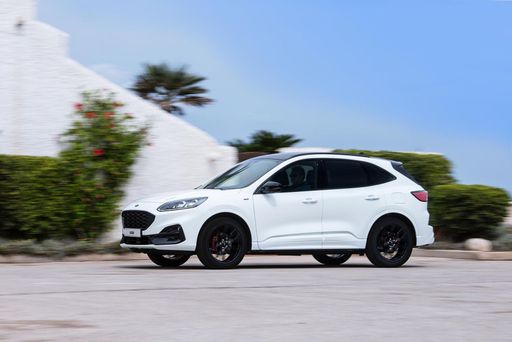 @ Ford Motor Company / Ford Media Center
@ Ford Motor Company / Ford Media Center
 @ Ford Motor Company / Ford Media Center
@ Ford Motor Company / Ford Media Center
Skoda Karoq
The Skoda Karoq is a smart, unfussy compact SUV that blends roomy practicality with a pleasantly composed driving character. It won’t turn heads at a car meet, but it will make daily life easier with clever storage, sensible ergonomics and a reassuringly grown-up ride.
details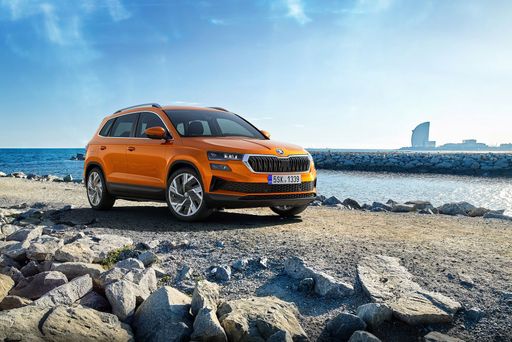 @ Škoda Auto a.s. / Škoda Storyboard
@ Škoda Auto a.s. / Škoda Storyboard
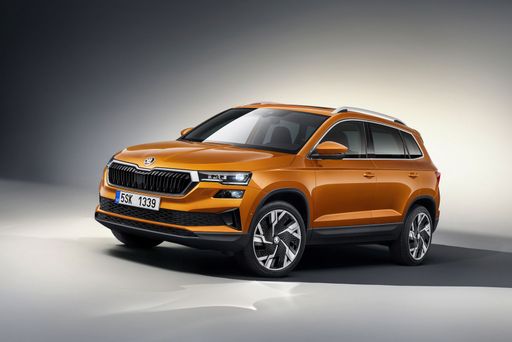 @ Škoda Auto a.s. / Škoda Storyboard
@ Škoda Auto a.s. / Škoda Storyboard
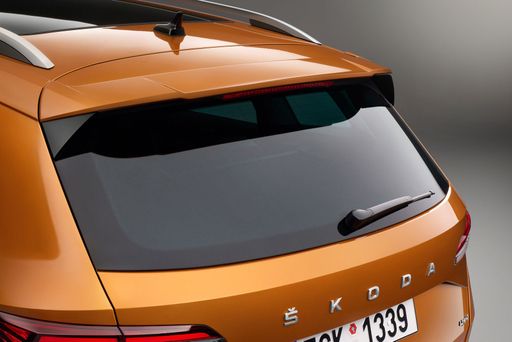 @ Škoda Auto a.s. / Škoda Storyboard
@ Škoda Auto a.s. / Škoda Storyboard
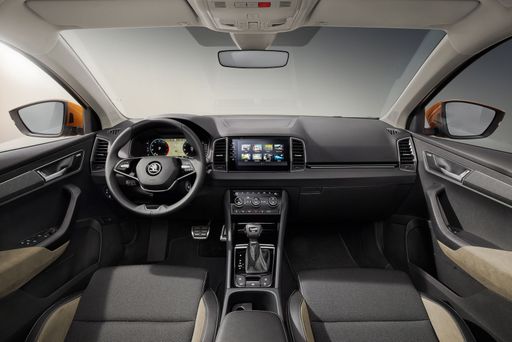 @ Škoda Auto a.s. / Škoda Storyboard
@ Škoda Auto a.s. / Škoda Storyboard
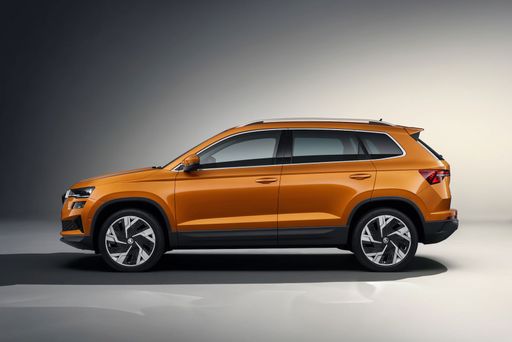 @ Škoda Auto a.s. / Škoda Storyboard
@ Škoda Auto a.s. / Škoda Storyboard
 @ Ford Motor Company / Ford Media Center
@ Ford Motor Company / Ford Media Center
|
 @ Škoda Auto a.s. / Škoda Storyboard
@ Škoda Auto a.s. / Škoda Storyboard
|
|
|
|
Costs and Consumption |
|
|---|---|
|
Price
34200 - 46300 £
|
Price
29100 - 41700 £
|
|
Consumption L/100km
2.8 - 6.8 L
|
Consumption L/100km
4.9 - 7.6 L
|
|
Consumption kWh/100km
-
|
Consumption kWh/100km
-
|
|
Electric Range
68 km
|
Electric Range
-
|
|
Battery Capacity
1.1 - 14.4 kWh
|
Battery Capacity
-
|
|
co2
55 - 154 g/km
|
co2
128 - 173 g/km
|
|
Fuel tank capacity
42 - 54 L
|
Fuel tank capacity
50 - 55 L
|
Dimensions and Body |
|
|---|---|
|
Body Type
SUV
|
Body Type
SUV
|
|
Seats
5
|
Seats
5
|
|
Doors
5
|
Doors
5
|
|
Curb weight
1526 - 1859 kg
|
Curb weight
1380 - 1655 kg
|
|
Trunk capacity
412 L
|
Trunk capacity
521 L
|
|
Length
4604 - 4645 mm
|
Length
4384 - 4390 mm
|
|
Width
1882 mm
|
Width
1841 mm
|
|
Height
1673 - 1681 mm
|
Height
1624 - 1629 mm
|
|
Max trunk capacity
1534 L
|
Max trunk capacity
1630 L
|
|
Payload
541 - 550 kg
|
Payload
456 - 549 kg
|
Engine and Performance |
|
|---|---|
|
Engine Type
Petrol, Full Hybrid, Plugin Hybrid
|
Engine Type
Petrol, Diesel
|
|
Transmission
Manuel, Automatic
|
Transmission
Manuel, Automatic
|
|
Transmission Detail
Manual Gearbox, CVT, Automatic Gearbox
|
Transmission Detail
Manual Gearbox, Dual-Clutch Automatic
|
|
Drive Type
Front-Wheel Drive, All-Wheel Drive
|
Drive Type
Front-Wheel Drive, All-Wheel Drive
|
|
Power HP
150 - 243 HP
|
Power HP
115 - 190 HP
|
|
Acceleration 0-100km/h
7.3 - 9.9 s
|
Acceleration 0-100km/h
7 - 11.2 s
|
|
Max Speed
195 - 200 km/h
|
Max Speed
192 - 221 km/h
|
|
Torque
240 Nm
|
Torque
200 - 360 Nm
|
|
Number of Cylinders
3 - 4
|
Number of Cylinders
3 - 4
|
|
Power kW
111 - 178 kW
|
Power kW
85 - 140 kW
|
|
Engine capacity
1496 - 2488 cm3
|
Engine capacity
999 - 1984 cm3
|
General |
|
|---|---|
|
Model Year
2025
|
Model Year
2025
|
|
CO2 Efficiency Class
E, D, B
|
CO2 Efficiency Class
D, E, F
|
|
Brand
Ford
|
Brand
Skoda
|
What drivetrain options does the Ford Kuga have?
The Ford Kuga is available as Front-Wheel Drive or All-Wheel Drive.
The prices and data displayed are estimates based on German list prices and may vary by country. This information is not legally binding.
